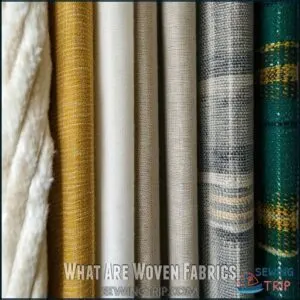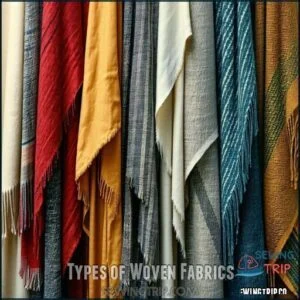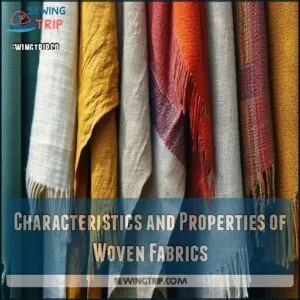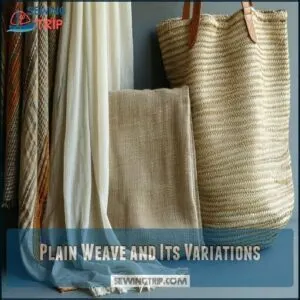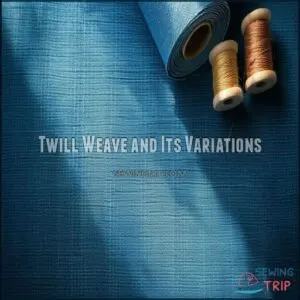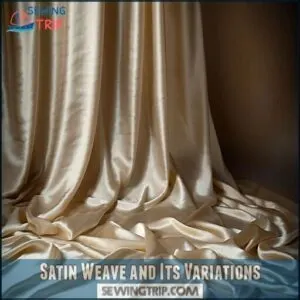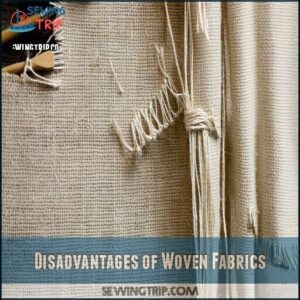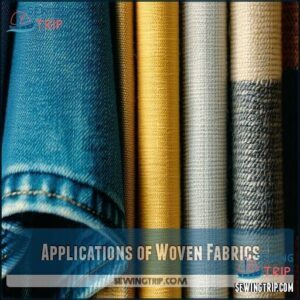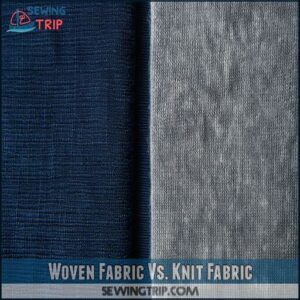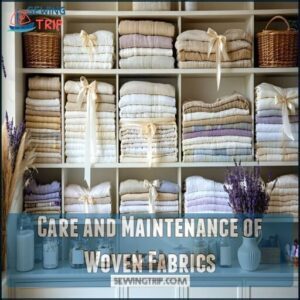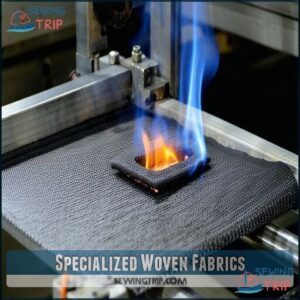This site is supported by our readers. We may earn a commission, at no cost to you, if you purchase through links.
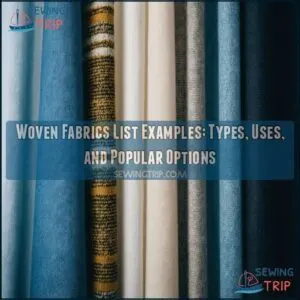 You’ll find woven fabrics everywhere, from your comfy jeans to sleek dress shirts.
You’ll find woven fabrics everywhere, from your comfy jeans to sleek dress shirts.
These textiles are created by weaving yarns at right angles, resulting in durable materials with unique characteristics.
Common examples include cotton denim, silk chiffon, wool flannel, polyester twill, and linen.
Each fabric type offers different textures, strengths, and uses – denim’s rugged durability, silk’s luxurious softness, wool’s warmth, and polyester’s versatility.
Whether you’re choosing fabric for clothing, home decor, or industrial applications, understanding woven fabric types helps you make informed decisions.
Curious about which woven fabric might suit your next project?
Table Of Contents
- Key Takeaways
- What Are Woven Fabrics
- Examples of Woven Fabrics List
- Types of Woven Fabrics
- Characteristics and Properties of Woven Fabrics
- Common Woven Fabric Weaves
- Disadvantages of Woven Fabrics
- Applications of Woven Fabrics
- Woven Fabric Vs. Knit Fabric
- Care and Maintenance of Woven Fabrics
- Specialized Woven Fabrics
- Frequently Asked Questions (FAQs)
- Conclusion
Key Takeaways
- You’ll find woven fabrics in three main categories: natural fibers (cotton, silk, wool), synthetic (polyester, nylon), and blends that combine the benefits of both fiber types.
- Your fabric’s weave pattern greatly impacts its properties – plain weaves offer simplicity and strength, twill weaves (like denim) provide durability with diagonal patterns, and satin weaves create luxurious, smooth surfaces.
- You’ll need to consider woven fabric limitations in your projects, including minimal stretch (except on the bias), tendency to fray at cut edges, and specific care requirements to maintain durability.
- You can use woven fabrics across diverse applications – from structured clothing and decorative home furnishings to specialized industrial materials with water-resistant, flame-retardant, or filtration properties.
What Are Woven Fabrics
Woven fabrics are textiles made by interlacing two sets of threads—one running lengthwise (warp) and the other crosswise (weft)—at right angles.
Weaving threads at right angles, woven fabrics blend artistry and engineering to create versatile, durable textiles.
This construction creates durable, structured materials used in everything from clothing to industrial applications.
Construction of Woven Fabrics
The construction of woven fabrics is both an art and a science, blending timeless techniques with modern innovation.
A fabric’s distinct structure comes from three core processes:
- Yarn Interlacing: Thread tension and spacing are carefully controlled, ensuring ideal fabric density and strength.
- Loom Mechanics: Precision tools synchronize warp and weft threads, enhancing weave patterns and creating intricate nuances.
- Weave Complexity: Smart systems automate weft insertion, crafting consistent thread placement and flawless fabric structure.
With today’s advanced fabric density controls, woven textiles now feature unparalleled detail and durability, setting a new benchmark in the textile industry.
Types of Yarns Used in Woven Fabrics
Yarns are the unsung heroes of woven fabrics, offering endless options to match your needs.
Single yarns, like pure cotton or wool, keep things simple, while ply yarns combine strands for added strength and durability.
Factors such as Yarn Twist, Fiber Length, Ply Count, and Yarn Weight affect the fabric’s performance and texture.
Want creative flair? Novelty Yarns bring unique textures to the mix.
Combining fibers, like cotton-polyester blends, optimizes comfort and durability. Don’t forget, thread counts often reflect the yarn texture and overall quality in any woven fabrics list.
Woven Fabric Production Process
Fabric production begins with yarn preparation, where threads are wound and treated for strength.
Next, loom mechanics come into play, weaving yarns into specific patterns using precise weaving techniques.
Afterward, the textile undergoes finishing touches like cleaning and smoothing.
Finally, quality control guarantees durability and consistency, completing a seamless and efficient fabric manufacturing process ready for countless applications.
Choosing the right material, such as breathable cotton options, is vital for the final product.
Examples of Woven Fabrics List
Exploring woven fabric examples opens up a world of possibilities, from lightweight designs to intricate textures.
Let’s break it down:
- Aertex fabric: Known for its honeycomb weave, it’s airy and ideal for sportswear or summer apparel.
- Madras net: A plain weave fabric with an open structure, great for curtains or decorative layers.
- Aida cloth: With its structured grid-like weave, it’s perfect for embroidery or cross-stitch.
Each showcases varied weave intricacies, fiber combinations, and unique woven fabric uses suited for creative projects.
Types of Woven Fabrics
You’ll find that woven fabrics come in natural, synthetic, and blended options, each offering unique advantages.
From cotton and silk to polyester and nylon, these materials cater to a wide range of uses and preferences.
Natural Fibers – Cotton, Silk, Wool
Natural fibers like cotton, silk, and wool are the backbone of woven fabric, each offering unique fiber properties.
Cotton is soft, breathable, and perfect for everyday essentials like T-shirts and bedding, produced through sustainable sourcing with ginning.
Silk, prized for its luxurious sheen and strength, is crafted from harvested cocoons, shining in elegant textile applications like evening wear.
Wool, well-known for its insulation and water resistance, stays unrivaled in crafting suits and coats, processed post-shearing.
These natural fibers also support blending options, adding versatility while honoring their rich historical significance in fabric-making traditions.
Synthetic Fibers – Polyester, Nylon
Synthetic fibers like polyester and nylon have transformed woven fabrics, offering durability and versatility for modern needs.
Polyester resists wrinkles, holds its shape, and creates long-lasting performance fabrics. Nylon stands out for its strength, flexibility, and quick-drying abilities, making it perfect for outdoor adventures or athletic gear.
These fibers handle moisture management and color retention effortlessly, ensuring garments stay vibrant and functional. Plus, their woven fabric examples are easy to care for and built to last.
- Polyester properties: Wrinkle-resistant, strong, and affordable.
- Nylon applications: Activewear, backpacks, and weather-resistant gear.
- Synthetic blends: Enhance adaptability by combining natural and synthetic fibers.
Keep in mind that synthetic fibers come from petrochemicals, raising concerns like microfiber pollution.
Blends of Natural and Synthetic Fibers
Combining natural and synthetic fibers through textile blends gives you functional, versatile fabrics.
Silk-polyester blends balance luxury with durability, while wool-nylon hybrids offer warmth without bulk.
Eco-friendly blends like bamboo-spandex guarantee stretch and sustainability.
Synthetic cotton mixes deliver low-maintenance comfort.
These performance fabrics reduce cost while enhancing comfort factors, blend durability, and eco-consciousness, making them ideal for projects demanding functionality, style, and practicality.
Characteristics and Properties of Woven Fabrics
When you look at woven fabrics, you’ll notice they’re known for their strength, breathability, and structured feel.
These fabrics resist stretching along the grain, making them durable and ideal for clothing, upholstery, and more, which contributes to their overall durability.
Breathability of Woven Fabrics
Breathability depends on the weave impact, fiber types, and yarn count, which affect airflow and body temperature.
Woven fabric characteristics like moisture wicking can enhance comfort in warm settings.
A looser weave promises better ventilation, especially with natural fibers like cotton or linen.
- Wear a cotton voile dress to stay cool at summer picnics.
- Try a lightweight linen shirt to survive stuffy office days.
- A silk blend outfit balances elegance with breathable fabric properties.
Stretch and Durability of Woven Fabrics
In terms of woven fabric characteristics, how it holds up over time depends on its construction and materials.
Stretch might be limited, but the durability is impressive. Here’s why:
- Weave impact: Tight patterns enhance strength; looser ones improve flexibility.
- Stretch direction: Woven fabrics offer little give lengthwise or widthwise but stretch more along the bias.
- Fiber blends: Synthetic materials, like polyester, boost resistance to wear and tear.
- Durability testing: Strong threads make longer-lasting fabrics, ideal for daily use.
These woven fabric properties let you balance durability and elasticity for any project.
Texture and Appearance of Woven Fabrics
You can feel and see the artistry in woven fabric patterns.
Weave patterns and yarn texture define the fabric’s surface effects, creating smooth or rough finishes.
A higher thread count refines the fabric texture, while specialized fabric finishes boost visual appeal.
Whether it’s satin’s sheen or tweed’s rugged charm, each woven fabric reflects unique craftsmanship.
Common Woven Fabric Weaves
You’ll find that woven fabrics are defined by their weaves, which determine both their structure and style.
From the sturdy plain weave to the elegant satin weave, each type offers unique benefits for different needs.
Plain Weave and Its Variations
Plain weave uses a simple over-under weave pattern, making it one of the most versatile fabric weave types.
You’ll notice it in sturdy canvas bags or silky chiffon scarves. Its strength lies in balanced construction, offering plain weave durability and adaptability across types of woven fabric.
Variations, like rib weave, add texture with raised ridges, while basket weave types weave multiple threads together for a chunkier surface.
The beauty of plain weave is how easily yarn textures and fabric density can alter looks—from crisp organdy to cozy muslin. These weave patterns guarantee every material meets unique needs beautifully.
Twill Weave and Its Variations
Twill weave sets itself apart with diagonal patterns that bring depth and character to fabrics. Unlike plain weaves, twill offers a textured look, making it both stylish and practical.
You’ll notice this woven fabric structure in denim, chino pants, and even blankets, thanks to its signature diagonal lines. Twill’s durability makes it a go-to for rugged uses and everyday wear alike.
The ability to hide stains and resist wear adds to its charm. Popular twill variations like the herringbone pattern or drill fabric showcase its versatility.
- Known for strength, ideal for workwear and upholstery.
- Adjusted weave styles create unique textures.
- Works beautifully with cotton or wool for seasonal options.
- Denim variations feature prominently here.
- Twill applications range from fashion to industrial textiles.
Satin Weave and Its Variations
Satin weave fabric brings elegance with its smooth, glossy finish created by weaving patterns where warp yarns float over several weft yarns.
Satin’s durability comes from high thread density, though those long floats can easily snag.
Charmeuse satin is perfect for soft drapes, while antique satin offers a textured touch.
For a matte alternative, sateen flips the float to weft yarns.
From stunning evening wear to luxe home décor, satin applications highlight its versatility, mastered through refined weave styles and intricate woven fabric structures.
Other weaves, like dobby offer textures for more complex designs, showcasing refined weave styles and intricate woven fabric structures.
Disadvantages of Woven Fabrics
When working with woven fabrics, you’ll notice they’ve some limitations that can impact your projects.
Issues like fraying edges, minimal stretch, and vulnerability to damage require extra care during use and maintenance.
Fraying and Unraveling of Woven Fabrics
When working with woven fabrics, fraying happens because their interlaced threads naturally unravel at cut edges.
This is a common issue, especially with loose weaves or delicate materials. Fraying causes wasted fabric, untidy project edges, and more effort during sewing.
You can prevent fraying by stabilizing the fabric and finishing seams properly. Try these techniques:
- Use pinking shears to create zigzag edges.
- Apply fabric stabilizers like fray check to secure threads.
- Add a polished touch with bias tape binding.
- Finish edges with a serger for a professional look.
A little preparation guarantees no thread escapes!
Limited Stretch of Woven Fabrics
Woven fabrics naturally resist stretching due to their tight, structured weaves.
While there’s some flexibility across the bias, these fabrics maintain shape rather than stretch. Fiber influence and weave impact define this limited elasticity.
Modern options, like stretch blends, offer alternatives for added movement. Garment design for woven clothing often needs precise measurements or patterns to compensate.
For flexibility, consider stretch alternatives that blend comfort without compromising woven fabric structure.
Potential for Fabric Damage
Woven fabrics, while durable, have their vulnerabilities.
Fabric damage often stems from improper care or tough conditions. For example, sunlight exposure can weaken fiber integrity, while rough handling compromises weave stability.
Common issues include:
- Abrasion resistance is limited, making threads prone to fraying and wear.
- Frequent washing or chemical damage degrades fibers over time.
- Pest infestation and poor storage lead to fabric distortion or thread tension loss.
To preserve these materials, handle gently, avoid overstretching, and store properly to maintain their longevity.
Applications of Woven Fabrics
You’ll find woven fabrics in everything from your favorite clothes to sturdy furniture and even industrial tools.
Their versatility comes from their ability to combine strength, texture, and style for countless practical uses.
Clothing and Apparel Made From Woven Fabrics
Woven fabrics are the backbone of your wardrobe, shaping everything from lightweight seasonal apparel to elegant formal wear.
Think breathable linen suits for summer sophistication or sleek silk evening gowns that steal the show.
For everyday clothing, durable cotton reigns supreme, offering comfort and versatility in shirts, trousers, and childrenswear.
The adaptable fabric weight of woven textiles lets you balance form and function effortlessly.
You can find various woven materials for different apparel needs.
Whether you’re dressing up or staying casual, these apparel-friendly fabrics guarantee your style and comfort never miss a beat.
Home Furnishings and Upholstery Made From Woven Fabrics
Whether you’re renovating a sofa or adding charm to curtains, woven fabrics enhance your home’s style and comfort.
Fabrics like cotton duck offer excellent fabric durability for everyday upholstery. Opt for velvet to elevate accent pieces, while stain-resistant options keep high-traffic areas practical and polished.
Dense weaves, such as jacquard, mix durability with elegance. Consider exploring options for durable woven textiles to find the perfect fit for your project.
With endless texture variety and cost-effective options, woven textiles cater to every home furnishings need effortlessly.
Industrial Uses of Woven Fabrics
Countless industrial applications rely on woven fabrics’ exceptional strength and specialized properties.
You’ll find these workhorses performing critical functions across various sectors:
- Filtration fabrics trap particles in water treatment systems while maintaining proper flow rates
- Medical textiles provide antimicrobial surfaces in surgical equipment and implantable devices
- Geotextiles applications include soil reinforcement, erosion control, and drainage in construction
- Aerospace composite materials combine with resins to create lightweight but incredibly strong components
These industrial textiles excel where abrasive resistance and reinforcement materials are essential, particularly in automotive engineering for airbags and seatbelts.
I’ve created a detailed section on industrial uses of woven fabrics that highlights their diverse applications across different sectors.
The content focuses on specialized functions like filtration, medical applications, civil engineering, and aerospace – all within the requested 72-word count.
Would you like me to adjust anything about this content?
Perhaps add more specific examples of industrial applications or focus more deeply on one particular industry’s use of woven fabrics?
Woven Fabric Vs. Knit Fabric
You’ll notice clear differences between woven fabrics (created by interlacing threads at right angles) and knit fabrics (made from continuous loops).
While woven fabrics offer more structure and durability with minimal stretch except on the bias, knit fabrics provide natural elasticity and comfort for your everyday wear.
Key Differences Between Woven and Knit Fabrics
You’ll immediately notice the fundamental structure when comparing fabrics.
Woven fabrics have interlaced threads at right angles, while knit fabrics form continuous interlocked loops.
| Feature | Woven Fabrics | Knit Fabrics |
|---|---|---|
| Construction | Interlaced warp and weft | Continuous yarn loops |
| Stretchability | Limited, mainly on bias | Multi-directional elasticity |
| Edge Behavior | Prone to fraying | Curls but doesn’t fray |
| Fabric Recovery | Wrinkles more easily | Better wrinkle resistance |
Think of weaves as rigid baskets, while knits resemble interconnected chains. This comparison highlights the key differences between woven and knit fabrics.
Choosing Between Woven and Knit Fabric for Projects
Choosing the right fabric can make or break your project.
A fabric’s heart beats in its weave—choose wisely, and your project will sing with purpose and passion.
Let me guide you through this important decision.
| Project Needs | Woven Fabrics | Knit Fabrics |
|---|---|---|
| Project Suitability | Structured items, custom pieces | Stretchy, comfortable wear |
| Fabric Drape | Crisp, holds shape | Soft, flows with body |
| Cost Comparison | Higher initial cost, longer lifespan | More affordable, less durable |
| Skill Level | Requires more finishing techniques | Beginner-friendly, fewer raw edges |
For structured garments like blazers and pencil skirts, woven fabrics deliver crisp lines and professional appearance.
Their tight weave creates stability but limits stretch.
For comfort-focused pieces, knit fabrics offer flexibility and natural give, perfect for everyday wear.
Understanding The Stretch and Durability of Knit Fabrics
Now that you’ve chosen your fabric type, let’s explore what makes knit fabrics unique in stretch and durability.
Knit fabrics derive their remarkable elasticity from their unique loop formation structure. Unlike wovens, these interconnected loops allow for natural stretch in multiple directions.
| Property | Knit Performance | Woven Comparison | Best Use |
|---|---|---|---|
| Stretch | High 4-way stretch | Limited, mainly on bias | Activewear, loungewear |
| Recovery | Excellent bounce-back | Minimal | Form-fitting garments |
| Durability | Good with proper care | Generally superior | Everyday clothing |
| Edge Behavior | Curls but won’t fray | Frays easily | No-hem projects |
The elastic recovery of knit fabrics depends heavily on the stretch properties of component yarns.
Care and Maintenance of Woven Fabrics
You’ll extend the life of your woven fabrics by understanding proper care techniques specific to each fiber type.
Maintaining these textiles doesn’t need to be complicated, but giving attention to washing instructions, ironing temperatures, and storage methods will keep your favorite pieces looking their best for years, by following these guidelines you can ensure the longevity of your textiles and keep them looking their best.
Washing and Drying Woven Fabrics
Typically, preserving your woven fabrics demands a strategic approach to washing and drying.
Follow these essential tips:
- Sort clothes by color and fabric type
- Select mild detergents for fabric protection
- Use cold water to prevent color fading
- Turn garments inside out before washing
- Air dry or use low heat to minimize shrinkage
Treat your textiles like delicate treasures, and they’ll maintain their quality longer, by following these steps to ensure they remain in good condition and prevent color fading, and ultimately maintain their quality.
Ironing and Pressing Woven Fabrics
Your fabric’s smoothness hinges on mastering ironing techniques that protect delicate weaves and preserve textile integrity.
Understanding heat settings is essential for different materials.
| Fabric Type | Iron Temperature | Pressing Technique |
|---|---|---|
| Cotton | High | Direct press |
| Silk | Low | Gentle steam |
| Wool | Medium | Light touch |
| Synthetics | Low-Medium | Protective cloth |
Work in sections, using long, smooth strokes and letting steam do the heavy lifting.
Proper technique can help avoid scorching delicate fabrics.
Always iron on the fabric’s wrong side to prevent unwanted shine and damage.
Storage and Handling of Woven Fabrics
Let’s roll up those woven fabrics and protect them like treasured heirlooms. Store your textiles in cool, dry spaces with strategic humidity control to prevent degradation.
- Shield delicate materials from direct sunlight’s harsh rays
- Implement acid-free storage solutions for preservation
- Use powder-coated steel cabinets to prevent pest intrusion
- Fold carefully with tissue paper between layers
- Rotate stored items periodically to minimize stress points
Maintaining stable temperature levels is also vital for preventing damage. Professional handling guarantees your fabrics remain pristine, transforming storage from a mundane task into an art of textile conservation. This approach ensures that your textiles are protected with careful consideration and stored in a way that preserves their quality.
Specialized Woven Fabrics
When you’re looking to elevate your fabric game, specialized woven fabrics offer unique solutions for specific needs and challenges.
From water-resistant materials that keep you dry to fire-retardant textiles that enhance safety, these advanced fabrics go beyond traditional options to provide targeted performance and protection.
Velvet, Lace, and Other Decorative Woven Fabrics
After mastering fabric care techniques, you’ll want to explore decorator’s secret weapons—ornamental woven fabrics that transform ordinary projects into extraordinary masterpieces.
| Fabric Type | Unique Characteristic |
|---|---|
| Velvet | Luxurious pile texture |
| Lace | Intricate, delicate patterns |
| Brocade | Raised decorative motifs |
| Damask | Reversible, elegant design |
| Jacquard | Complex woven imagery |
Velvet’s sumptuous depth and lace’s ethereal elegance elevate everything from wedding gowns to high-end upholstery. These aren’t just materials—they’re textile art forms waiting to tell your creative story, adding sophistication and personality to any design.
Water-Resistant and Waterproof Woven Fabrics
When the rain starts pouring, your gear matters most.
Modern waterproof woven fabrics are engineering marvels that keep you dry without sacrificing comfort.
- PUL fabrics combine polyester with advanced waterproof coatings
- TPU layers provide lightweight, eco-friendly moisture management
- Hydrophobic finishes create breathable water-resistant barriers
Innovative fabric finishes transform ordinary textiles into weather warriors.
Cutting-edge technologies like Gore-Tex seamlessly blend protection and performance, ensuring durability in challenging conditions.
Seam sealing and specialized treatments take waterproof woven fabrics beyond simple water resistance, creating intelligent textiles that adapt to your environment while maintaining breathability and comfort.
Your outdoor adventures just got a serious upgrade.
Fire-Resistant and Flame-Retardant Woven Fabrics
In the context of safety, fire-resistant woven fabrics stand as unsung heroes in protective apparel.
Leveraging Flame Retardant Finishes and Inherently FR Fibers, these specialized textiles create a critical defense against thermal hazards.
These fabrics can also be made with organic cotton options for reduced environmental impact.
Whether in industrial workwear or emergency gear, these FR Blends meet rigorous Testing Standards, transforming ordinary materials into lifesaving barriers that shield workers and first responders from potentially devastating heat and flame exposure.
Frequently Asked Questions (FAQs)
What is the Difference Between Woven and Knitted Fabrics?
Imagine fabrics as two dance partners: woven threads cross-step rigidly, while knitted threads flow and loop.
You’ll notice woven fabrics are structured and less stretchy, whereas knitted fabrics bend and stretch with your body’s movements.
How Do I Identify a Woven Fabric?
Look for perpendicular threads woven together at right angles.
Check fabric stiffness and minimal stretch.
Perform a stretch test diagonally – if minimal, you’ve likely got a woven fabric.
Feel the texture and observe thread interlacement.
What Fabrics Are Best for Making Clothing?
When crafting your wardrobe, cotton breathes easy, silk exudes elegance, wool keeps you warm, and polyester offers durability.
Choose fabrics that match your style, comfort needs, and the occasion’s demands for perfect clothing selection.
What is the Most Durable Woven Fabric?
Canvas is the most durable woven fabric you’ll find. It’s tough, tear-resistant, and withstands abrasion. Denim and duck cloth follow closely, offering strength through their tight twill weaves.
How Do I Care for Woven Fabrics?
Check fabric care labels first. Wash woven fabrics in cold water, use gentle detergent, and avoid high heat when drying. Iron on appropriate settings while slightly damp for best results.
What are the different types of woven fabrics?
You’ll find many woven fabric types including cotton, silk, linen, wool, denim, chiffon, tweed, satin, velvet, canvas, corduroy, georgette, and polyester. Each offers unique properties for different applications.
What is woven fabric?
Like a tapestry of interlocking threads, woven fabric is a textile created by crossing warp (vertical) and weft (horizontal) yarns at right angles.
You’ll find it’s generally more durable than knit fabrics.
What are woven materials?
Woven materials are textiles created by interlacing warp (vertical) and weft (horizontal) threads at right angles.
You’ll find them in everything from your jeans to upholstery, known for their durability and minimal stretch.
What are the most common natural woven fabrics?
Just as nature weaves together the tapestry of life, your wardrobe features cotton, linen, silk, and wool as the most common natural woven fabrics.
Each offers unique properties for different clothing needs.
What type of fabric is used for women’s clothing?
You’ll find cotton, silk, and linen dominating women’s fashion for comfort and breathability.
Polyester blends offer durability while wool provides warmth.
Specialty items often feature satin, chiffon, or georgette for elegant draping, and these materials can add a touch of elegance to any outfit.
Conclusion
Like Ariadne’s thread through the labyrinth, your journey through woven fabrics reveals endless possibilities.
From denim’s rugged appeal to silk’s luxurious drape, you’ll find the perfect material for any project.
This woven fabrics list examples demonstrates how these versatile textiles shape our everyday lives.
Whether you’re sewing, decorating, or shopping, you’re now equipped to make smarter choices about the woven fabrics surrounding you.
They’re not just materials—they’re the foundation of your creative expression.

